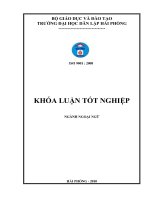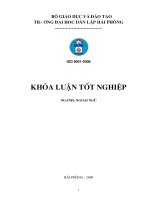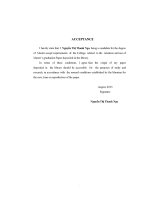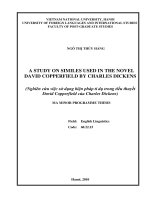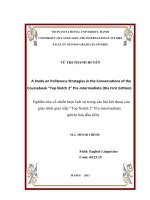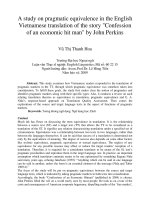A STUDY ON COMPOUND NOUNS IN THE NOVEL “JANE EYRE” BY CHARLOTTE BRONTE
Bạn đang xem bản rút gọn của tài liệu. Xem và tải ngay bản đầy đủ của tài liệu tại đây (327.81 KB, 58 trang )
BỘ GIÁO DỤC VÀ ĐÀO TẠO
TRƯỜNG ĐẠI HỌC DÂN LẬP HẢI PHỊNG
-------------------------------
ISO 9001 : 2008
KHĨA LUẬN TỐT NGHIỆP
NGÀNH NGOẠI NGỮ
HẢI PHÒNG - 2010
HAIPHONG PRIVATE UNIVESITY
FOREIGN LANGUAGES DEPARTMENT
-----------------------------------
GRADUATION PAPER
A STUDY ON COMPOUND NOUNS IN THE NOVEL
“JANE EYRE” BY CHARLOTTE BRONTE
By:
DƯƠNG THỊ NGÂN
Class:
NA1004
Supervisor:
ĐẶNG THỊ VÂN, M.A
HAI PHONG - 2010
BỘ GIÁO DỤC VÀ ĐÀO TẠO
TRƯỜNG ĐẠI HỌC DÂN LẬP HẢI PHÒNG
--------------------------------------
Nhiệm vụ đề tài tốt nghiệp
Sinh viên: ............................................................Mã số: ............................
Lớp: .............................Ngành:....................................................................
Tên đề tài: .................................................................................................
..................................................................................................
.................................................................................................
..................................................................................................
Nhiệm vụ đề tài
1. Nội dung và các yêu cầu cần giải quyết trong nhiệm vụ đề tài tốt nghiệp
( về lý luận, thực tiễn, các số liệu cần tính toán và các bản vẽ).
……………………………………………………………………………..
……………………………………………………………………………..
……………………………………………………………………………..
……………………………………………………………………………..
……………………………………………………………………………..
……………………………………………………………………………..
……………………………………………………………………………..
……………………………………………………………………………..
2. Các số liệu cần thiết để thiết kế, tính tốn.
……………………………………………………………………………..
……………………………………………………………………………..
……………………………………………………………………………..
……………………………………………………………………………..
……………………………………………………………………………..
……………………………………………………………………………..
……………………………………………………………………………..
……………………………………………………………………………..
……………………………………………………………………………..
3. Địa điểm thực tập tốt nghiệp.
……………………………………………………………………………..
……………………………………………………………………………..
……………………………………………………………………………..
CÁN BỘ HƯỚNG DẪN ĐỀ TÀI
Người hướng dẫn thứ nhất:
Họ và tên: .............................................................................................
Học hàm, học vị: ...................................................................................
Cơ quan công tác:.................................................................................
Nội dung hướng dẫn:............................................................................
Người hướng dẫn thứ hai:
Họ và tên:.............................................................................................
Học hàm, học vị:...................................................................................
Cơ quan công tác:.................................................................................
Nội dung hướng dẫn:............................................................................
Đề tài tốt nghiệp được giao ngày 12 tháng 04 năm 2010
Yêu cầu phải hoàn thành xong trước ngày 10 tháng 07 năm 2010
Đã nhận nhiệm vụ ĐTTN
Sinh viên
Đã giao nhiệm vụ ĐTTN
Người hướng dẫn
Hải Phòng, ngày tháng năm 2010
HIỆU TRƯỞNG
GS.TS.NGƯT Trần Hữu Nghị
PHẦN NHẬN XÉT TÓM TẮT CỦA CÁN BỘ HƯỚNG DẪN
1. Tinh thần thái độ của sinh viên trong quá trình làm đề tài tốt nghiệp:
……………………………………………………………………………..
……………………………………………………………………………..
……………………………………………………………………………..
……………………………………………………………………………..
……………………………………………………………………………..
……………………………………………………………………………..
……………………………………………………………………………..
……………………………………………………………………………..
2. Đánh giá chất lượng của khóa luận (so với nội dung yêu cầu đã đề ra trong
nhiệm vụ Đ.T. T.N trên các mặt lý luận, thực tiễn, tính tốn số liệu…):
……………………………………………………………………………..
……………………………………………………………………………..
……………………………………………………………………………..
……………………………………………………………………………..
……………………………………………………………………………..
……………………………………………………………………………..
……………………………………………………………………………..
……………………………………………………………………………..
……………………………………………………………………………..
3. Cho điểm của cán bộ hướng dẫn (ghi bằng cả số và chữ):
……………………………………………………………………………..
……………………………………………………………………………..
……………………………………………………………………………..
Hải Phòng, ngày ….. tháng ..… năm 2010
Cán bộ hướng dẫn
(họ tên và chữ ký)
NHẬN XÉT ĐÁNH GIÁ
CỦA NGƯỜI CHẤM PHẢN BIỆN ĐỀ TÀI TỐT NGHIỆP
1. Đánh giá chất lượng đề tài tốt nghiệp về các mặt thu thập và phân tích tài liệu,
số liệu ban đầu, giá trị lí luận và thực tiễn của đề tài.
2. Cho điểm của người chấm phản biện :
(Điểm ghi bằng số và chữ)
Ngày.......... tháng......... năm 2010
Người chấm phản biện
ACKNOWLEDGEMENTS
From bottom of my heart, I would like to show my deepest gratitude to many
people helping and encouraging me enthusiastically in preparing and completing
the graduation paper.
First of all, I would like to express my heart felt thanks to Mrs. Dang Thi Van,
(MA), my supervisor, who has given me many valuable guidance, correction and
advices for my research.
Also, I would like to thank Mrs. Tran Thi Ngoc Lien - Dean of Foreign
Language Department for her help during my completion of the paper.
Next, I am also grateful to all teachers at Hai Phong Private University, whose
support and advices has improved my study.
Last but not least, I owe sincere thanks to all members of my family and friends
for whatever they supported and encouraged me both mentally and physically in
the progress of writing this graduation paper.
I know my graduation paper still keeping mistakes for my shortcomings. I
would like to receive your comments, suggestions and corrections for the perfect of
my own graduation paper.
Hai Phong, June 2010
Duong Thi Ngan
TABLE OF CONTENTS:
Part one: INTRODUCTION
1. Rationale of the study
2. Aims of the study.
3. Methods of the study.
4. Scope of the study.
5. Design of the study.
Part two: DEVELOPMENT
CHAPTER ONE: THEORETICAL BACKGROUND
I. 1. Noun in English.
I. 1 .1. Definition.
I. 1. 2. Classification.
I. 1. 2.1. Classification by meaning.
1. Common noun.
2. Proper noun.
3. Abstract nouns.
4. Concrete noun
5. Collective noun.
I. 1. 2. 2. Classification by structure:
1. Simple nouns.
2. Compound nouns.
3. Complex nouns.
I. 1. 2. 3 Classification by relationship with other components like case, gender,
number...
1. Singular nouns and plural nouns.
2. Countable nouns and uncountable nouns.
3. Nouns of masculine, feminine, common and neuter gender.
I.1.3 Grammatical functions.
.
1. Noun as Subject (S).
2. Noun as Direct Object (Od).
3. Noun as Indirect Object (Oi).
4. Noun as Subject Complement (Cs).
5. Noun as Object Complement (Co).
6. Noun as Adverbial (A).
I. 2. Compound noun in English:
I. 2.1. What is compounding?
I. 2. 2. Definition of compound nouns.
I. 2. 3. Characteristics of compound nouns.
1. Structurally, a compound noun consists of at least two root morphemes.
2. The components of a compound noun can be simple or derived word and even
other compound words.
3. The function of compound nouns.
4. Common English compound nouns.
I. 2. 4. Classification of compound nouns.
I. 2. 4. 1.According to the meaning.
1. Non-idiomatic compound nouns.
2. Idiomatic compound nouns.
I. 2. 4. 2. According to componential relationship.
1. Coordinative compound nouns.
2. Subordinative compound nouns.
I. 2. 4. 3. According to the compositional types.
1. Compound noun formed by juxtaposition.
2. Compound noun formed by morphological mean.
3. Compound noun formed by syntactical mean.
4. Compound noun formed by both morphological and syntactical means.
I. 2. 4. 4. Word-class combination compound nouns.
I. 2. 5. Miscellanea of compound nouns.
1. Derivational compound nouns.
2. Reduplicative compound nouns.
3. Faded compound nouns.
4. Dead compound nouns.
5. Compound noun formed by “prepositional adverb”.
I. 2. 6. Criteria of compound nouns.
1. Phonological criterion.
2. Inseparability criterion.
3. Graphic criterion (spelling criterion).
3. 1. The “solid” or “closed” form.
3. 2. The hyphenated form.
3. 3. The “open” or “spaced” form (as two separated words).
4. Semantic criterion.
CHAPTER TWO: A STUDY ON COMPOUND NOUNS IN THE NOVEL
“JANE EYRE” BY CHARLOTTE BRONTE.
II. 1 General view of compound nouns in the novel “Jane Eyre”.
II. 2. The frequency of compound nouns in the novel “Jane Eyre”:
II. 2. 1. Coordinative and subordinative compound nouns.
1. Coordinative compound nouns.
2. Subordinative compound nouns.
II. 2. 2. Non-idiomatic compound nouns and idiomatic compound nouns.
1. Non-idiomatic compound nouns.
2. Idiomatic compound nouns.
II. 2. 3. Compositional types of compound nouns.
1. Compound nouns formed by juxtaposition.
2. Compound nouns formed by morphological mean.
3. Compound nouns formed by syntactical mean.
4. Compound nouns formed by both morphological and syntactical means.
II. 2. 4. Word-class combination compound nouns.
1. Noun-noun compound nouns.
2. Noun-verb compound nouns.
3. Noun-adverb compound nouns.
4. Verb-noun compound nouns.
5. Verb-adverb compound nouns.
6. Adjective-noun compound nouns.
7. Adjective-verb compound nouns.
8. Adverb-noun compound nouns.
9. Adverb-verb compound nouns.
10. Verb-verb compound nouns.
II. 2. 5. Miscellanea of compound nouns.
1. Derivational compound nouns.
2. Reduplicative compound nouns.
3. Faded compound nouns.
4. Dead compound nouns.
5. Compound noun formed by “prepositional adverb”.
II. 3. The effectiveness of using compound nouns in the novel "Jane Eyre".
CHAPTER THREE: SOME PROBLEMS RELATED TO COMPOUND
NOUNS IN THE NOVEL "JANE EYRE"
III. 1. Misunderstanding the meaning of compound nouns.
III. 2. Getting difficulties in distinguish compound nouns and other word classes.
III. 3. Confusing when translating compound nouns from English into Vietnamese:
III. 4. Some suggested solutions.
1. Phonological criterion.
2. Inseparability criterion.
3. Semantic criterion.
4. Graphic criterion.
Part three: CONCLUSION
REFERENCES
APPENDIX
Exercises
Key
PART ONE: INTRODUCTION
1.
Rationale of the study.
Nowadays, English becomes the most widely used language in the world,
80% of world information stored in English
(vietbao.vn/Giao-duc/Tieng-Anh-thong-tri-the-gioi/30174410/202/).
English also is an international language used in all aspects like: education,
medicine, economy, science, tourism, culture, etc.
In my opinion, English is not easy but very profound and interesting to
study.
English learners always understand that in our life, English is vital. Thanks
to English, different nations with different languages and culture could close
together.
Grammar is an essential part of every language. L.G Alexander (2009:p1)
denoted that we should learn grammar because "there is no point in learning
grammar for the sake of learning grammar. Grammar is the support system of
communication and we learn it to communicate better. Grammar explains the
"why" and "how" of language. We learn it because we just can't do without it."
In English, nouns account most proportion and types of nouns are various
but compound nouns seem to be most attractive.
Literature is not only vital spiritual of people but also serves as one of the
best ways for better understanding between nations.
The novel "Jane Eyre" by Charlotte Bronte, one of four famous works we
learnt in the subject "English-American literature", was written with many
compound nouns. With students of English, recognizing and analyzing compound
nouns is not simple and may cause some problems.
Therefore, I choose “a study on compound nouns in the novel "Jane Eyre"
by Charlotte Bronte" as title of my graduation paper. I hope that the study could
show English learners the characteristics and the usage of compound nouns in the
novel "Jane Eyre".
2. Aims of the study.
My study aims to:
Provide learners some characteristics and classification of compound nouns
in order to facilitate the effective use of these compound nouns.
Point out the structure of compound nouns in the novel "Jane Eyre" to
classify these compound nouns more easily and exactly.
Find out the frequency of compound nouns in the novel "Jane Eyre" to
hypothesize the presence of these compound nouns in this novel.
Identify some problems related to compound nouns used in the novel "Jane
Eyre" and give some suggested solutions to overcome.
3.
Methods of the study.
The method of the study is data collection. First, data was collected from the
reference books as well as internet to have useful information. For instance, the
researcher read some reference books to find out definitions that are necessary for
"chapter one: Theoretical background"; and many examples as well.
The data is then analyzed in order to show the frequency of compound
nouns in the novel "Jane Eyre".
Furthermore, from analyzing the frequency of compound nouns in the novel,
some possible problems are identifide. Basing on the researcher's knowledge and
experience, some solutions to these problems are point out.
4.
Scope of the study.
I could not take a study on all issues related to compound nouns because of
my knowledge and experience. Furthermore, I could not take a study on all
literature works due to the time frame. So, my study only focuses on compound
nouns in the novel "Jane Eyre". The study
expresses the general view on
compound nouns, frequency and their effectiveness in the novel "Jane Eyre".
5.
Design of the study.
My study includes three main parts but the second is the most important one.
The first, INTRODUCTION, presents about rationale, aims, methods, scope, and
the design of the study.
The second, DEVELOPMENT, consists of three following chapters:
Chapter one shows an overview of some theoretical concepts such as
definition, classification of noun; and definition, classification and criteria of
English compound nouns.
Chapter two gives an investigation into compound nouns in the novel "Jane
Eyre".
Chapter three highlights some problems related to compound nouns in the
novel and some suggested solutions to these problems.
The third, CONCLUSION, summaries the study mentioned above.
PART TWO: DEVELOPMENT
CHAPTER I: THEORETICAL BACKGROND
I. 1. Noun in English.
I. 1. 1. Definition.
The term "noun" seems to be a simple concept but in fact, it quite difficult to
define.
In process of studying, I found some definitions of noun:
Randolph Quirk (1987:p21) defined nouns as "entities that are regarded as
stable, whether these are concrete (physical) like house, table, paper, or abstract
(of the mind) like hope, botany, length”.
Richard Nordquist denoted that noun is the part of speech (or word class)
that is used to name a person, place, thing, quality, or action. Adjective: nominal.
A noun can function as the subject or object of a verb, the object of a preposition,
or an appositive
( />Noun is a content word that can be used to refer to a person, place, thing,
quality or action
Noun is the word class that can serve as a subject or object of a verb, the
object of a preposition or in apposition.
( />In the first definition, noun was defined by meaning and in the second one; it
was defined by grammatical functions.
A word used as the designation or appellation of a creature or thing, existing
in fact or in thought; a substantive.
( />In linguistics, a noun is a member of a large, open lexical category whose
members can occur as the main word in the subject or clause.
( />A noun is a word used to name a person, animal, place, thing, and abstract
idea. Nouns are usually the first words which small children learn.
( />So, noun can be defined like that "a noun is a word belonging to "openclass" and referring to a person, place, thing, quality or action.
Note:
“Open-class" items belong to a class in that they have the same grammatical
properties and structural possibility as
Other member of the class but it is indefinitely extendable. "Open-class" is
contrary to "closed-system".
"Open-class" includes noun, verb, adjective, and adverb; meanwhile,
"closed-system"
embraces
article,
demonstrative,
pronoun,
preposition,
conjunction, and interjection.
I. 1. 2. Classification.
Do Thanh Loan (2003; p9) divided nouns into these following types by
two ways of classification:
I. 1. 2. 1. Classification by meaning:
1. Common noun.
A common noun is a word that names people, places, things, or ideas. They
are not the names of a single person, place or thing.
A common noun begins with a lowercase letter unless it is at the beginning
of a sentence.
E.g.:
People:-Man, girl, boy, mother, father, child, person, teacher, student
Animals:-Cat, dog, fish, ant, snake…
Things:-Book, table, chair, phone
Places:-School, city, building, shop
Ideas:-Love, hate, idea, pride
( />2. Proper noun.
Proper nouns (also called proper names) are the words which name specific
people, organizations or places. They always start with a capital letter.
E.g.:
Each part of a person's name is a proper noun:-Lynne Hand - Elizabeth
Helen Ruth Jones...
The names of companies, organizations or trade marks:-Microsoft Rolls Royce - the Round Table - WWW
Given or pet names of animals:-Lassie Trigger Sam
The names of cities and countries and words derived from those proper
nouns:-Paris - London - New York - England - English
Geographical and Celestial Names:-The Red Sea - Alpha Centauri - Mars
Monuments, buildings, meeting rooms: - The Taj Mahal - The Eiffel
Tower - Room 222
Historical events, documents, laws, and periods: - The Civil War - the
Industrial Revolution - World War I
Months, days of the week, holidays: - Monday - Christmas - December
Religions, deities, scriptures:- God - Christ - Jehovah - Christianity Judaism - Islam - the Bible - the Koran - the Torah
Awards, vehicles, vehicle models and names, brand names:- The Nobel
Peace Prize - the Scout Movement - Ford Focus - the Bismarck - Kleenex – Hoover
( />2.
Abstract nouns.
An abstract noun is a noun that you cannot sense; it is the name we give to
an emotion, ideal or idea. They have no physical existence, you can't see, hear,
touch, smell or taste them…
E.g.:
Justice; an idea, bravery and happiness are all abstract nouns.
( />An abstract noun is a type of noun that refers to something a person cannot
physically interact with. A noun is a person, place or thing.
However, in many cases, the 'thing' might be an intangible concept, which
means it is an abstract form of noun.
In this instance, abstract means to exist apart from concrete existence. A
noun that is abstract is an aspect, concept, idea, experience, state of being, trait,
quality, feeling, or other entity that cannot be experienced with the five senses.
E.g.:
Emotions/Feelings: love, hate, anger, peace, pride, sympathy...
States/Attributes:
bravery,
loyalty,
honesty,
integrity,
compassion,
success...
Ideas/Concepts/Ideals: beliefs, dreams, justice, truth, faith...
Movements/Events: progress, education, trouble, leisure, friendship...
( />4. Concrete noun
A concrete noun is the name of something or someone that we experience
through our senses, sight, hearing, smell, touch or taste. Most nouns are concrete
nouns. The opposite of a concrete noun is an abstract noun.
E.g.:
Examples of Concrete Nouns
Common Concrete Nouns
Countable Concrete Nouns
dog, cat, girl, plate air, water etc.
singular -chair, computer, song, window
plural - chairs, computers, songs, windows
Uncountable Concrete Nouns
water, air, oil, sugar, salt, rice, cheese etc.
Proper Nouns
Mr. Mike Jones, Tom Brown, Audrey Ryan
( />
5.
Collective noun.
In linguistics, a collective noun is a word used to define a group of objects,
where objects can be people, animals, emotions, inanimate things, concepts, or
other things.
E.g.: A gaggle (of geese), a convoy (of lorries), a team (of football), a group
(of people)...
( />
I. 1. 2. 2. Classification by structure:
1. Simple nouns.
Simple noun is a single noun formed by only one roots. The simple noun
may be the word formed by affixation.
E.g.:
1)Leather, bread, meat, flour, thread, wheel…
( />2. Compound nouns
Compound noun is a noun formed by compounding. There are at least 2
roots in the compound noun.
E.g.: housekeeper, shop assistant, post office, hanger-on, inside...
3. Complex nouns.
Complex noun phrases contain three components: pre-modification, head
noun and post-modification.
The head noun is the central element and core component of the complex
noun phrase.
Pre-modification, also called pre-modifiers, including modifiers that stand
before the head noun. Pre-modifiers can be closed-system and/or open-class items.
The third important component of a complex noun phrase is postmodification, called post-modifiers, comprising all the items placed after the head.
These post-modifiers are mainly realized by prepositional phrases, finite
clauses (or relative clauses), nonfinite clauses, adjective phrases, noun phrases or
adverbial phrases:
E.g.:
Premodification
Head
prediterminer determiner postdeterminer
the
all
both
the
the
their
which Mr. Mark decorated
yesterday
students in the class
shirts
sole
books
on the table
( />house
last
English
Postmodification


